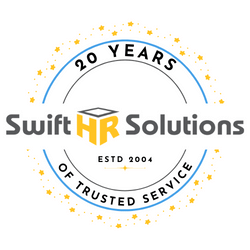How it Started
Swift HR Solutions, Inc. is celebrating 20 years in business. In honor of this milestone, we’ll be sharing about how we started, our guiding values, our trusted Consultants, and more in our 20th anniversary blog series.
Building a Brand
Swift HR Solutions was founded in 2004 by Shannon SwifT, a self-professed “startup junkie”. Shannon had a passion for working with smart people, doing cool stuff, in a fast-paced environment. After a successful career in several HR executive roles, she wanted to bring her experience to more small technology startups.
Shannon recalls, “My whole career was with early stage companies. I was employee number 8 at one company and grew with them to 110 employees. I was employee number 12 with another organization that grew to 150. I knew the impact that strategic HR could have on a company even in the earliest stages. I wanted to help make sure leaders weren’t distracted by HR issues, and that HR was actually supporting the business and contributing to its success.”
Many startups tend to put off hiring an HR executive until they are closer to 100 people, and instead focus on transactional HR to tackle benefits, compliance and on/off-boarding. Shannon knew those organizations were missing out on strategically building an intentional culture with philosophies around benefits, compensation, and recruiting. She knew there was a better way.
As Shannon embarked on her entrepreneurial journey, she knew three things for certain:
First, she didn’t want to spend time tracking time. “I wanted to spend time doing great HR work for my Clients, not tracking billable hours.”
Secondly, she didn't want to feel like a consultant. “Instead of being at arm’s length, I wanted to feel like I was part of my Client's company.”
Lastly, she didn't want to do compartmentalized project work. “I believe that every aspect of HR affects the rest. So I preferred to take a holistic approach to HR, starting with culture and values, and then making sure that every single thing that touches the employees from compensation to benefits to employee communication to performance management is intentionally supporting the culture and values.”
Swift HR Solution’s first Client was an entrepreneur-in-residence with a Seattle VC firm who had heard of Shannon’s plan to launch her own business. He approached her 6 weeks before she was planning to incorporate, as he had just stepped in as CEO of a tech company and saw no sign of HR. He and Shannon worked together to create a business model that achieved all of Shannon’s key objectives: a flat monthly retainer charge for dedicated time each week, along with full time access through phone and email. This fractional model was an opportunity to give the quality of an executive level HR resource for her Client at a price he could afford, and still serves as our basic framework for HR services today.
Up and Running
As referrals continued to come in, Shannon quickly ran out of days in the week and reached out to a trusted colleague to double her capacity. Shannon continued to add long-time, respected HR colleagues as the list of Clients grew, and the first three “Swifties” are all still with the company today!
In early 2005, the fractional model was given the ultimate test when Shannon was referred to a secretive new startup called Zillow with only two people on payroll. She was able to jump in as the first VP of HR with a one day per week retainer and begin laying the foundation for this rapidly growing company. After a few months, she added a second day per week and grew the recruiting and HR team as the company rapidly transformed from 2 to 140 employees over a two-year period. The ultimate compliment came when the CEO saw another company that had Shannon on their org chart and said, “I thought you were only working with us now?” She had achieved her goal of feeling like a full time presence for her Client’s company, on a fractional basis.
Up next: we’ll explore the Company values and what it means to be a “Swifty”.

